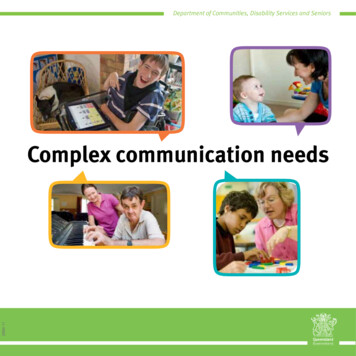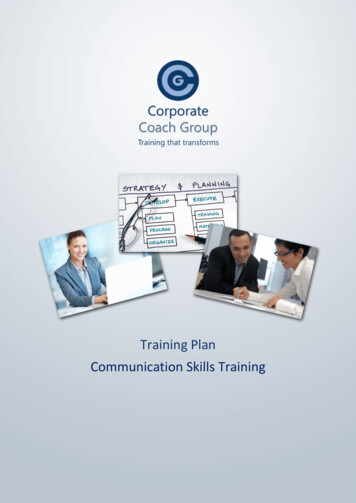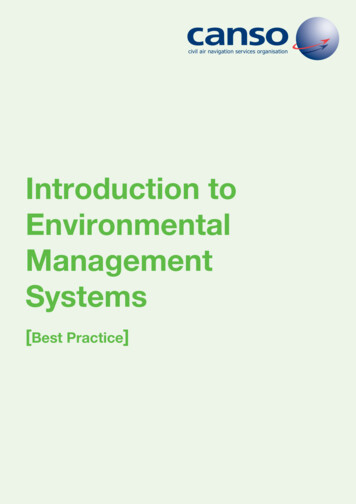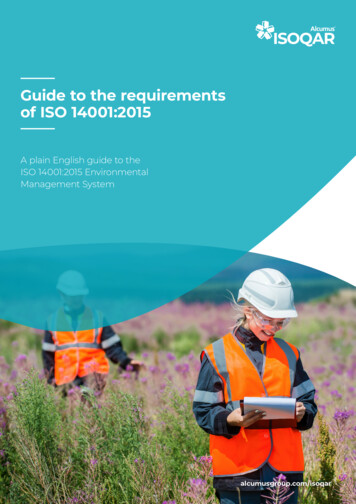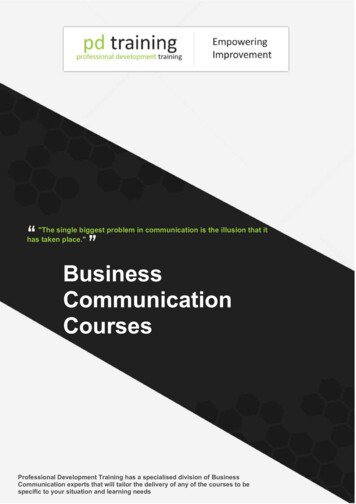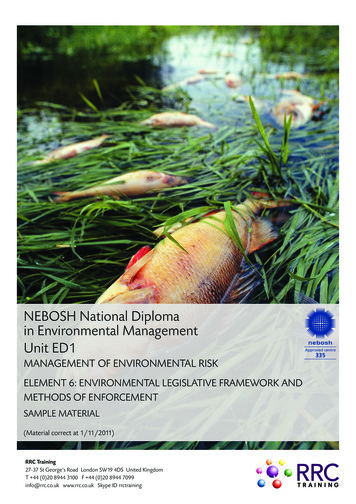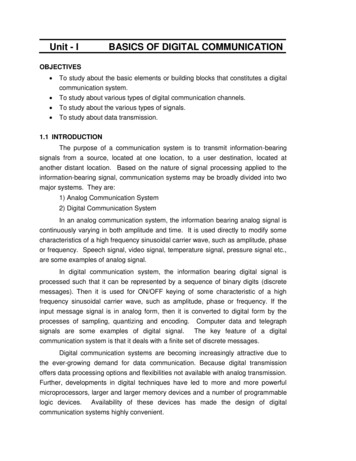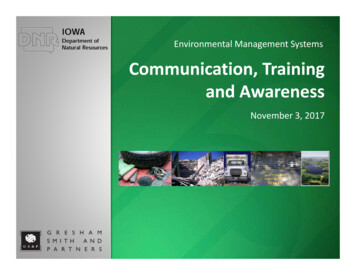
Transcription
Environmental Management SystemsCommunication, Trainingand AwarenessNovember 3, 2017
Communication/Training/Awareness ‐Iowa Establishprocesses for internal and externalcommunication. External communication willinclude reaching out to those groups andorganizations that have been identified as havingan interest, stake or role in the organization’songoing EMS program. There must also beprocedures for receiving and responding torelevant communication from external interestedparties.
Communication/Training/Awareness –Iowa (continued) Internalcommunication is directed to individuals,organizations and entities that have a role orresponsibility within the action plan. Training includes a process to ensure that allresponsible parties are familiar with the EMS andhave the skills necessary to capably execute theirroles.
Communication
EMS Communication Communication Achieving Support for the EMS Employees and External Participants Need to Understand IfThey Have a Responsibility for Action Plans to Achieve aTargetEmployee Buy In Without it, the EMS Becomes a Book on the ShelfMaking Progress on Objectives and Targets is Key in:Environmental Becomes Everyone’s JobStakeholder Buy In Crucial to Many Objectives and Targets
Internal EMS Communication TheGoal of Internal EMS Communication is toSystematically Raise the EMS Awareness ofInternal Staff Suggested Internal Communication Process Identify AudiencesIdentify Tools and Formats by AudienceIdentify Process for Receiving and Responding toInquiriesLaunch CommunicationFollow‐up with Inquiry/Communication (e.g., respondto and document)
Internal Communication Approach– Audiences Identify Audiences for EMS CommunicationBoard or Elected Officials Senior Management Field Staff Administrative Staff Other Considerations by Audience TypeTechnology Access and Availability Language Barriers Interest Level and Background Awareness Repeated and Consistent Message for All Audiences Consistent Messages Presented in Multiple Formats
Internal Communication Approach– Identify Tools and Formats Printed MediaEMS Logo and Branding Newsletters Brochures Hats/Shirts/Pens EventsEarth Day Celebrations Pollution Prevention Week ProgramsRecognition Programs ‐ What is Important to The AudienceLevel? Internal Competition Programs Based on Metrics Progress
EMS Communication MethodsEmail/Websites Meetings/Tailgate Safety Meetings Flyers/Brochures Training Posters Performance Plans Award/Recognition Programs Contracts Council Briefings Press Releases Town Hall Meetings Conversations at the Water Cooler
Internal Communication Approach– Receiving and Responding Identifyand Publish Methods for ReceivingInformation and Ideas Regarding the EMSThrough the EMR? Through Your Supervisor? Email? BeforeLaunching, Consider Responses andTimeframesTimeliness Ability to Track Ideas and Resulting Decisions Ability to Implement Changes Also Consider Scope of Internal CommunicationJust EMS or All Environmental Topics
External EMS CommunicationGoal is to Raise Awareness of the EMS and ExternalParticipation in Achieving Objective and Targets External EMS Awareness May Be Very DifferentDepending on Audience/Stakeholder Is the Audience Crucial to Achieving an Objective and Target? Or Does the Audience Need General Environmental/EMSAwareness? Things to ConsiderThe Environmental Policy Objectives and Targets and Action Plans Stakeholder Roles and Responsibilities Establish Procedures for Receiving and Responding toCommunication from Interested Parties
Examples
Eco Gecko – City of Scottsdale, AZ
Stall Talk
Communication Tracking ‐ Example
Communication Approach:Best Practices StartSmall With Easily Attainable Goals andReceptive Audiences Build Over Time Pair Audiences With Most AppropriateCommunication Tools and Format Keep Short and to the Point Consider Available Budget Encourage Friendly Competition Build on Existing Successful ProgramsCommunication Programs Will TakeTime to Develop and Execute
Training
Training Forthe EMS, Training May Focus on the FollowingAreas: Environmental Compliance and AssociatedRequirementsCompetency and/or License Requirements Such as 40‐Hour HAZWOPER or Confined Space EntryGeneral EMS Awareness TrainingMinimizing Environmental Impacts, IncludingEmergency ResponseResponsibilities for Objectives and Targets and ActionPlan ItemsGeneral Environmental and Stewardship Awareness
Training Program Components IdentifyTraining Needs, Frequency, and Provider Assign Training by Job Description/JobTitle/Facility Implement Training with Considerations of:Knowledge Level Staff Availability Language Frequency Track Training and Retain Training RecordsProblems Arise in Tracking Who Didn’t Attend Training
Training Needs, Frequency, andProvider RegulatoryInternal Storm Water Permit Annual Training Internal Right‐to‐Know Annual Training External Solid Waste Operators License A – One TimeOnly Internal Spill Response Training – One Time EMSTrainingInternal Annual Awareness Training Internal Objectives and Targets Leader Training – OneTime Stewardship TrainingBrownbag Lunches Once per Quarter
Assign Training by JobDescription/Job Title/FacilityTitleTraining ClassLaborerEMS AwarenessSpill Prevention and ResponseRight‐to‐KnowSupervisorEMS AwarenessSpill Prevention and ResponseRight‐to‐KnowEmergency EvacuationHazardous Waste Management
Implement Training Program
Track Training
Track Training
EMS Awareness Training AllEmployees Within the Fenceline Should beAble to Answer the Following Questions: Environmental Policy Environmental Aspects and Impacts What Does the Environmental Policy Say?How Does Your Job Impact the Environment?What Are You Doing About It?Communication Channels and Procedures Who Do You Call if You Have an Emergency?Who Do You Call if You Have an Environmental Question orIdea?
EMS Procedure DocumentYour Process ForInternal Communication External Communication Training and Awareness Include ResponsibilitiesParticularly For TrainingTracking and Delivery of Training Programs Must Include Process for Receiving andResponding to Inquiries from External Parties
Best Practices DevelopTraining Programs Considering AudienceInterest, Education Level, and Resources Every Training Class is an Opportunity to Make aDifference Avoid “Checking The Box” Remember the EMS Questions Every StaffMember Should Answer .Design Communicationand Training Accordingly Have a System for Tracking Training and Audit itOften
Communication, Training andAwareness ExercisesReport Out and Discussion
QUESTIONS?Leslie Goldsmith(515‐725‐8319 or Leslie.Goldsmith@dnr.iowa.gov)Cory Sander(614‐917‐3074 or cmsander@psara.com)Tom Dietrich(937‐408‐1775 or tom dietrich@gspnet.com)
Training Needs, Frequency, and Provider Regulatory Internal Storm Water Permit Annual Training Internal Right‐to‐Know Annual Training External Solid Waste Operators License A -One Time Only Internal Spill Response Training -One Time EMS Training Internal Annual Awareness Training Internal Objectives and Targets Leader Training -One


